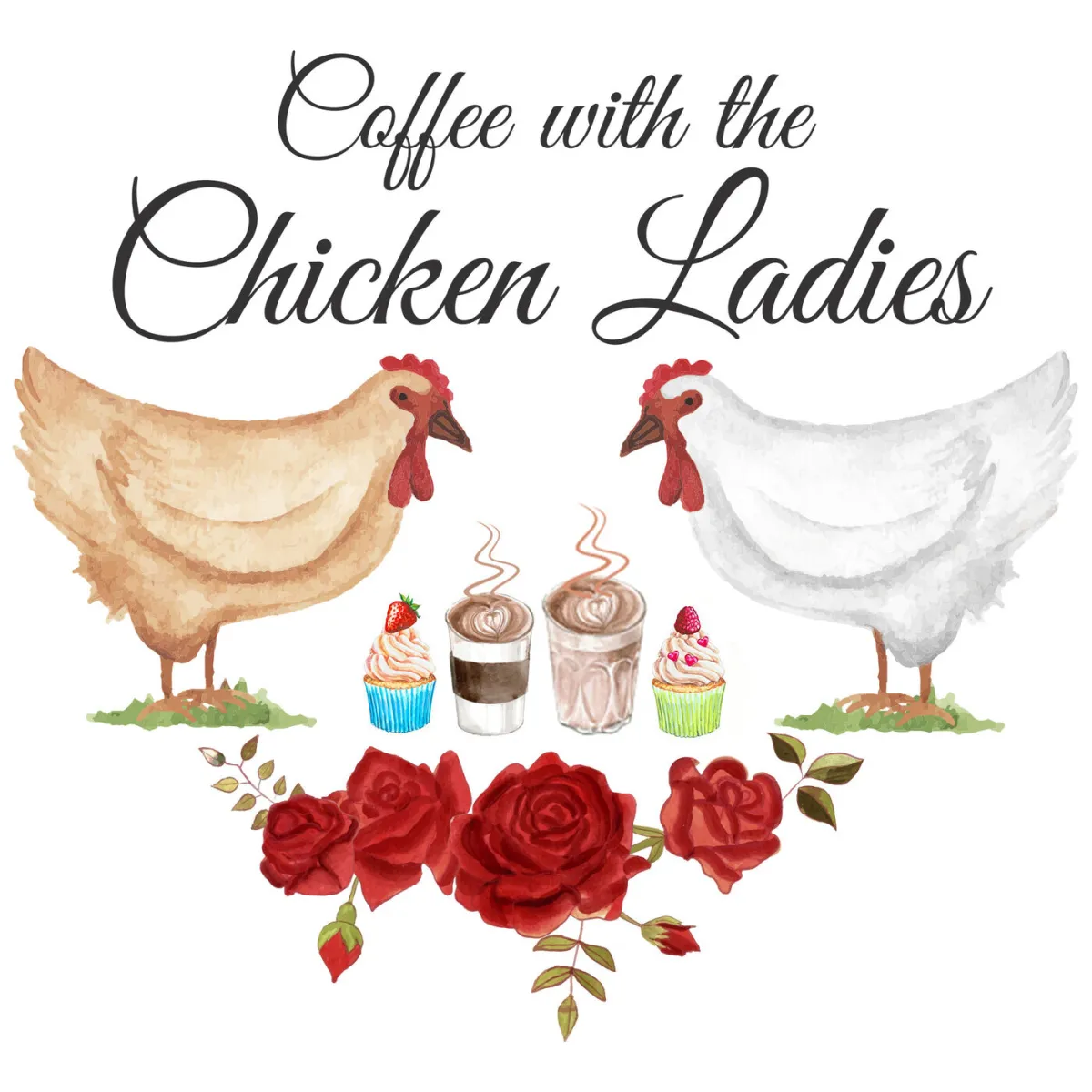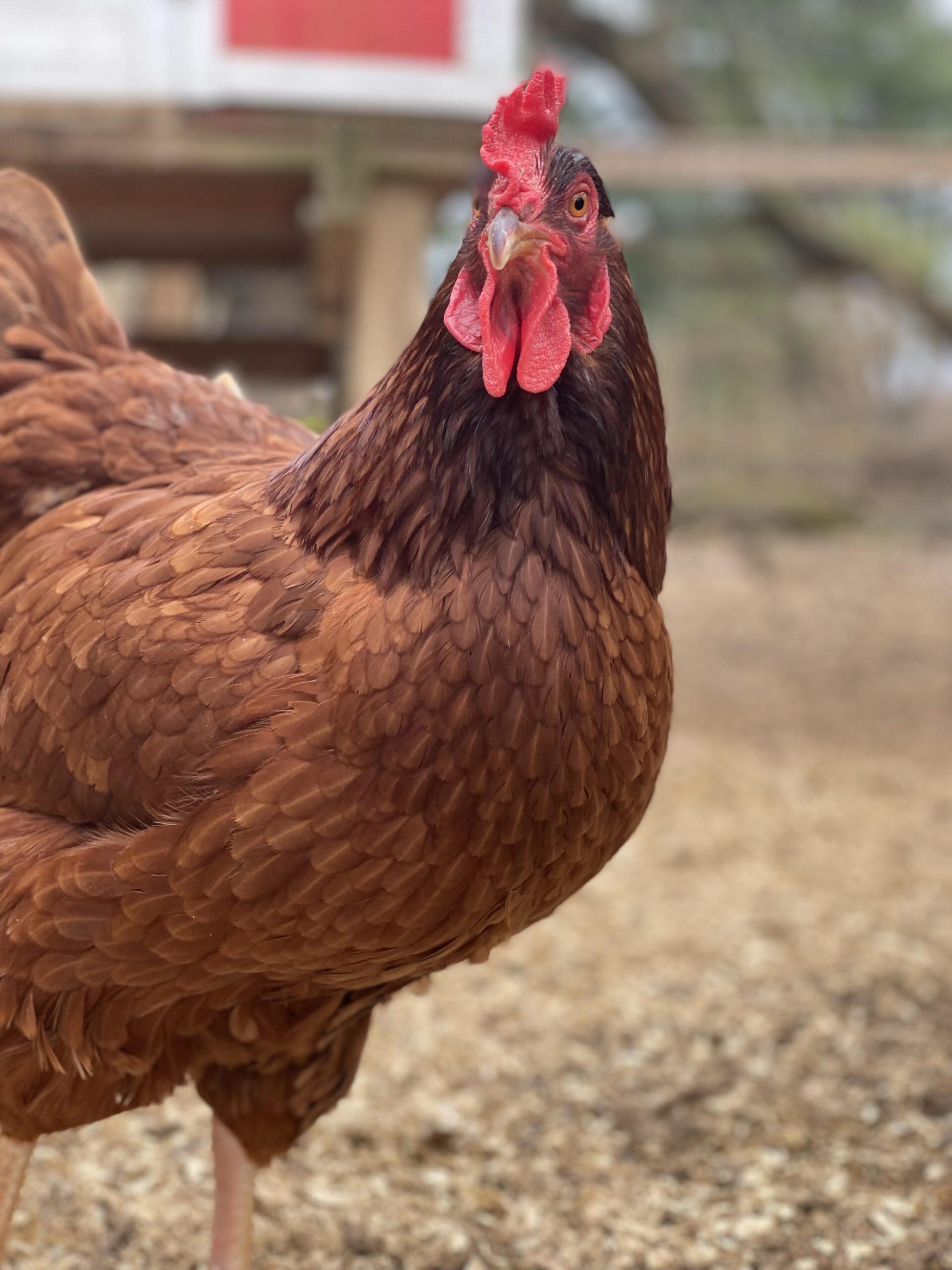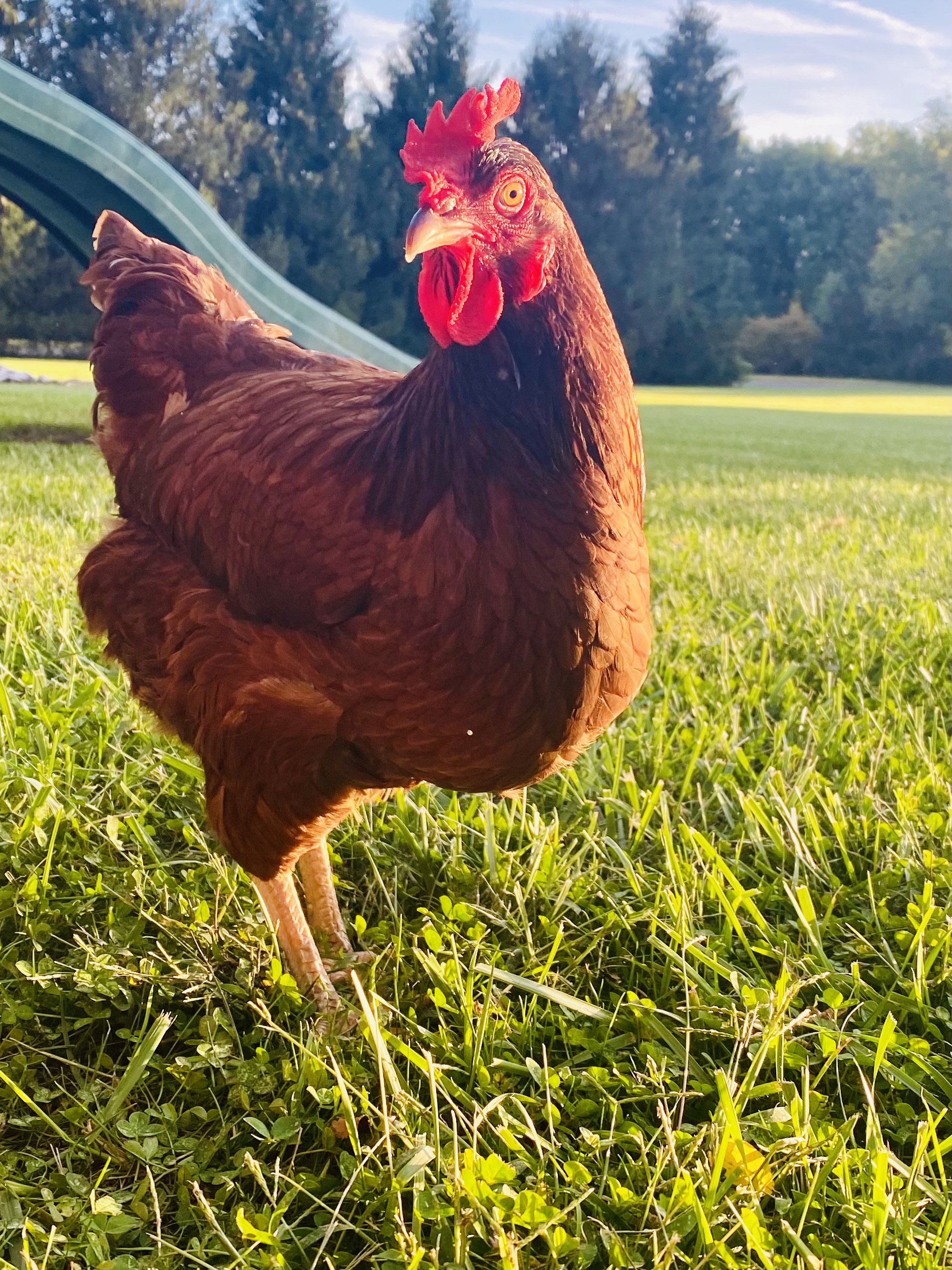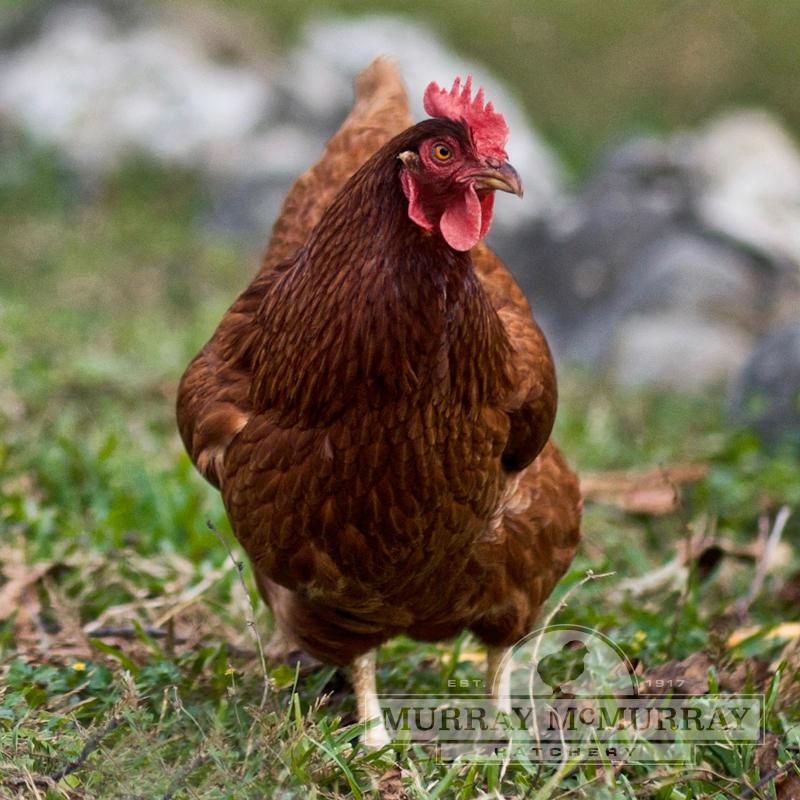We want to note that during the second half of the 20th century, Rhode Island Reds split into two lines. Heritage Rhode Island Reds became separate and distinct from industrial heavy-laying lines. The Heritage lines tended to be a bit larger, darker in color, and retained the instinct to go broody and hatch a clutch of eggs.
Rhode Island Red Heritage Chickens | Basic Breed Information
Rhode Island Reds are large breed fowl that only occur in one color – red. Though we’re used to seeing the straight combed Rhode Island Red, there is a rose comb variety as well. The straight combed Rhode Island Reds were accepted by the APA in 1904, and the rose combs were accepted in 1905. The Heritage line of Rhode Island Red graduated from the Livestock Conservancy’s Conservation Priority List in 2023. Hooray!
Rhode Island Red Heritage Chickens | Size and Appearance
As we mentioned, Rhode Island Reds come in two varieties – straight combed and rose combed. Both types are a lustrous, deep maroon red with black tail feathers. They have bright red faces and earlobes, clean, bright yellow legs, and a strong, blocky body. Roosters average about 8.5 lbs., while hens are about 6 lbs.
Rhode Island Red Heritage Chickens | Foundation Breeds
The American Poultry Association Standard of Perfection lists the Red Malay, the Brown Leghorn, and “Asiatic Native stock” as the foundation breeds. Other sources list the Shanghai chicken, which may refer to the Cochin, or could have been the Malay-like precursor to the Cochin. The Livestock Conservancy also lists the Java as a foundation breed, specifically the Auburn Java.
Rhode Island Red Heritage Chickens | History
Some breeds of chicken have a history that you see repeated over and over without any in depth research and documentation. In the case of the Rhode Island Red, here’s what you usually read: Rhode Island Reds were developed in New England during the late 19th and early 20th centuries. We did some in depth research because we wanted a better picture of the Rhode Island Red’s development.
The story starts – as so many do – with the captain of a fishing boat. Somewhere in the early 1850s, before the Civil War, before the U.S. was even 100 years old, Captain William Tripp acquired a Red Malay cockerel. At least one source says he bought it off of an English sailor, but the important part is this: Captain Tripp took his new Red Malay rooster home to New England and let it start breeding with his hens. Captain Tripp was very pleased with the resulting offspring. They reportedly laid more eggs than his other hens and worked very well as dual purpose birds.
Captain Tripp showed the birds to one of his close friends, John Macomber. Macomber ended his visit by taking some of Captain Tripp’s new crossbred birds to breed with his own chickens. The two men embarked on this breeding project, occasionally bringing in other breeds (including Brahmas/Chittigong, Javas, Cochins/Shanghai, etc.) and trading back and forth to minimize inbreeding. At this point in time, the birds did not have a standard appearance and were hatching with straight, rose, and even pea combs.
Eventually, the word got out (as it always does) that Macomber and Tripp had created an improved breed of chicken. Local farmers started buying birds from them and calling the chickens Macombers or Tripp’s Fowl. One of the farmers who bought stock from the pair was a man named Isaac Wilbour.
Wilbour ran a large egg farm in Little Compton Rhode Island, supplying eggs to the Boston and Providence markets. When he heard about these new chickens, he wanted to give them a try. Wilbour was the grandson of Isaac Wilbour, one of the early Governors of Rhode Island. He was very well connected socially and financially, and he is the person who really put the Rhode Island Reds on the map.
Wilbour brought his newly purchased Tripp’s Fowl home and started breeding them. He wanted to continue producing a dual purpose bird, but also wanted them to be great layers to support his egg business. He also wanted them to have large enough frames to deal with the cold New England winters. While we found nothing to prove this theory, we wonder if Wilbour was the breeder who added Brown Leghorn – which arrived in the U.S. in 1853 or earlier – to this mix for maximum egg production. Regardless, he carried on with breeding and in the late 1890s, two professors from the Rhode Island Agricultural Experiment Station – now known as the University of Rhode Island – came to visit his farm to see the chickens. They were extremely impressed and asked him to name this new breed. He chose Rhode Island Red.
Rhode Island Red Heritage Chickens | Laying and Hatching
Rhode Island Red hens are excellent layers of large brown eggs. You can expect between 250 and 300 large brown eggs per year from Heritage lines and 300+ per year from production lines. As we mentioned earlier, some of the older Heritage bloodlines have retained broody tendencies.
Rhode Island Red Heritage Chickens | Ideal Living Conditions
Rhode Island Red chickens check off a lot of boxes for all types of chicken keepers. They’re beautiful, excellent layers, great dual purpose birds for homesteads, rich in American history, and many are friendly enough for a snuggle. They tend to be very hardy, healthy birds and are reasonably tolerant of both hot and cold climates. The straight combed variety will require protection from frostbite on combs and wattles. Folks in areas with extreme winters may want to consider sourcing the rose comb variety.
Rhode Island Reds do well in mixed flocks if there are only one or two of them. Look out for large groups of Rhode Island Reds – they can become girl gang bullies. They are active and intelligent chickens that make great garden helpers and are wonderful additions to the Chicken Lady or Gent’s flock.
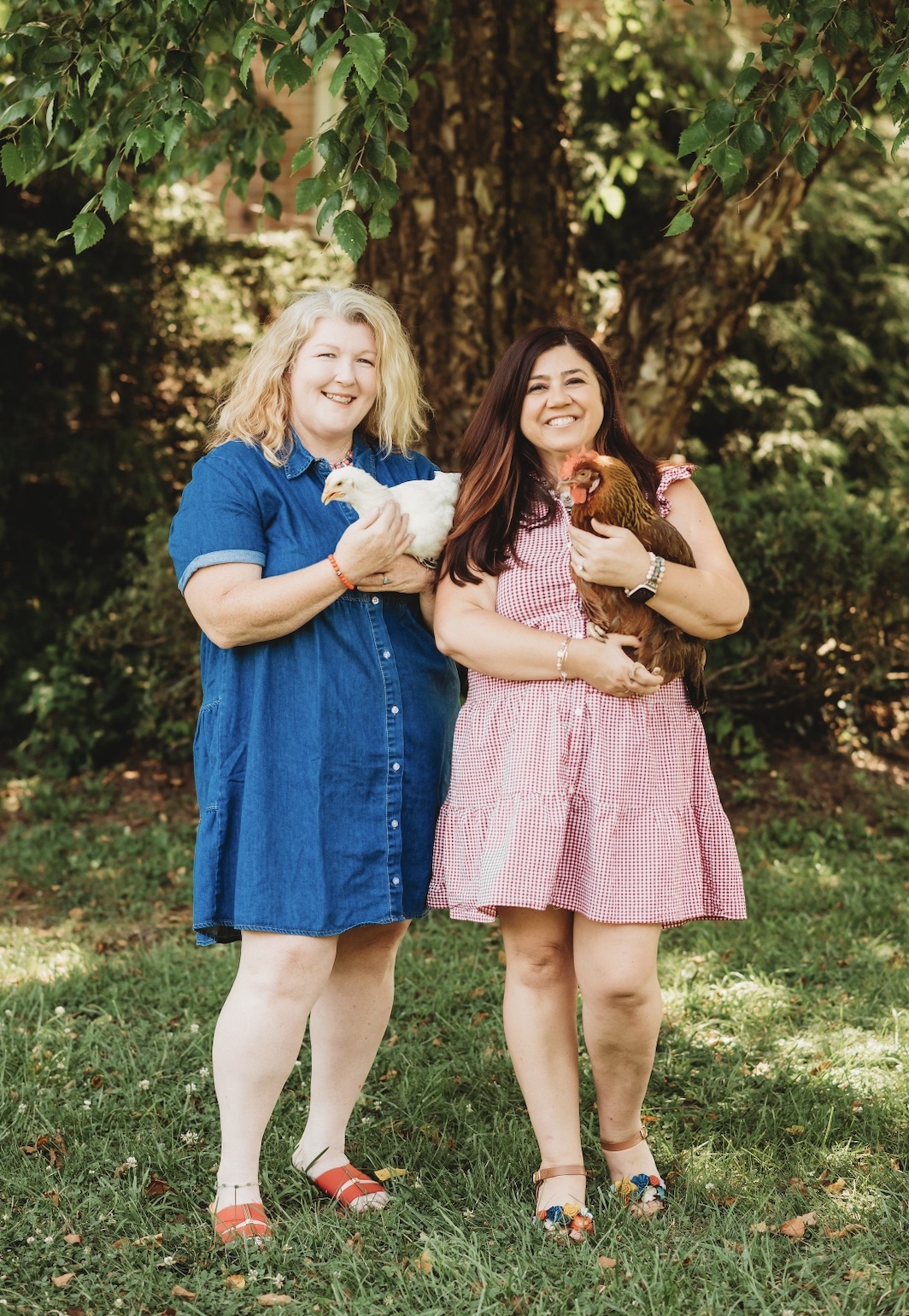
Holly Callahan-Kasmala grew up as a 4-H kid on a small horse farm. She has been keeping chickens for more than 20 years, and is passionate about Heritage chickens and helping people find the right breed for their needs. Holly has an MA in History, and is a long-time fiber artist/teacher. In addition to keeping Heritage breed chickens and rare breed sheep, she also grows heirloom cotton, dye plants, and all kinds of heirloom vegetables, fruit, and flowers on her small Maryland farm. She is the creator and co-host of Coffee with the Chicken Ladies Podcast.
Chrisie DiCarlo is a retired veterinary technician with a passion for helping people care for their poultry. During her 15 years in the field, she managed a technical trauma nursing care team in a busy urban veterinary hospital ER. She gave up her career to be a stay-at-home mom to her two amazing daughters. Chrisie has been keeping chickens for more than 7 years. She also loves growing herbs, fruit, and flowers on her small Maryland farm. She is the creator and co-host of Coffee with the Chicken Ladies Podcast.
Catch up on episodes of Coffee with the Chicken Ladies Podcast, stay up to date on their website, and follow along on social media.
Coffee with the Chicken Ladies Podcast
Coffee with the Chicken Ladies is a weekly podcast hosted by Chrisie DiCarlo and Holly Callahan-Kasmala. The podcast covers all things Pet Chicken! Each episode includes a breed spotlight, a relevant chicken keeping topic, a recipe using fresh eggs, and some retail therapy! The Chicken Ladies also feature interviews with expert guests who span the chicken keeping world. You’ll find the latest podcast episodes on their website, as well as other podcasting platforms.
You can learn more about Rhode Island Red chickens by listening to Episode 92 of their podcast.
